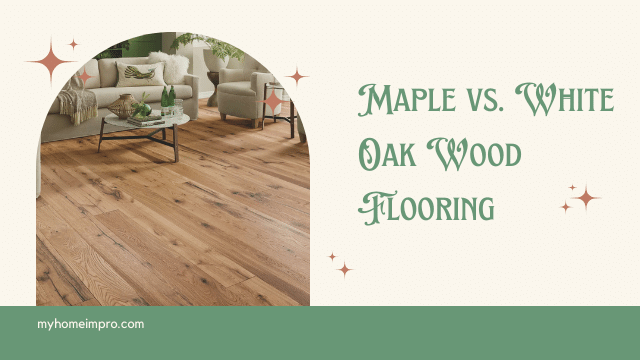When it comes to choosing the perfect flooring, the decision between maple and white oak wood can be a challenging one.
Both bring unique characteristics to the table and understanding their differences is crucial in making an informed choice for your space.
In this comprehensive guide, we delve into the distinctive features of maple and white oak wood flooring, helping you confidently navigate the decision-making process.
Let’s get started!
White Oak Wood Flooring vs. Maple Flooring: Which Should You Install?
Table of Contents
White oak and maple are both great choices for wood flooring, but understanding their difference will enable you to make better choices.
Understanding White Oak Wood Flooring
White oak flooring has gained immense popularity for its timeless appeal and durability. The term white oak refers to several species of oak trees that share similar characteristics.
One of the key advantages of white oak is its dense grain pattern, which gives it a smoother appearance than other oak varieties. White oak wood is known for its strength and resistance to wear, making it an excellent choice for high-traffic areas in your home.
Advantages of White Oak Wood Flooring
- Versatility: It adapts well to various stains and finishes, allowing you to customize the look to match your interior style.
- Resistance to Moisture: White oak has a natural resistance to moisture, making it suitable for kitchens and bathrooms. It is even used to make boats for this reason.
Exploring Maple Wood Flooring
Maple flooring, on the other hand, offers a distinct aesthetic that appeals to many homeowners. With its light, pale colour and fine grain pattern, maple adds a sense of brightness and warmth to any room.
Advantages of Maple Wood Flooring
- Aesthetic Appeal: The light colour of maple brightens up spaces, creating an inviting atmosphere.
- Ease of Maintenance: Maple is relatively easy to maintain via regular sweeping and occasional damp mopping.
- Stability: Maple is less prone to warping or shrinking, providing stability over time.
- Durability: If durability is a top priority, especially in areas prone to heavy use, maple stands out as the preferred choice.
1.Colour and Appearance
Maple tends to exhibit a lighter colour palette, ranging from creamy white to light brown. The light and neutral tones of maple can create a bright and airy feel. This makes it an excellent choice for rooms where you want to enhance natural light and create a visually open environment.
White oak flooring, on the other hand, offers a broader spectrum of colours, including light to medium browns with subtle undertones of pink or grey. This diverse colour range provides a richer, more varied visual appearance. The hint of undertones adds depth, making white oak a versatile choice that can complement a wide range of interior styles.
When deciding between maple and white oak, consider your existing decor, lighting conditions, and personal preferences to choose the option that aligns with your vision.
2.Hardness and Durability
White oak is generally quite durable and ideal for busy households, with a Janka scale rating of 1360. This characteristic is particularly advantageous in households with higher levels of foot traffic, pets, or children. The robust nature of white oak ensures that the flooring maintains its integrity even in demanding conditions.
Maple is harder than white oak flooring, with a Janka scale rating of 1450, and offers a good level of durability. It can withstand everyday wear and tear admirably.
For the best installation outcomes, make sure you understand how to acclimatize wood flooring before you install it.
3.Cost Considerations
Maple is often more affordable than white oak, making it an attractive option for those with budget constraints. Despite being a cost-effective alternative, maple doesn’t compromise on quality. Choosing maple allows you to achieve a stylish and durable flooring solution without breaking the bank.
With its diverse colour options, white oak may come with a higher price tag. While it offers excellent value in terms of durability and aesthetic versatility, it’s important to weigh this against your budget considerations. If budget is a significant factor and you’re looking for a durable and visually appealing option at a lower cost, maple is an enticing choice.
4.Ease of Maintenance
Maple is relatively easy to maintain, requiring regular sweeping and occasional damp mopping.
Its smooth and fine grain pattern requires minimal effort to keep it looking its best. Regular sweeping or vacuuming is usually sufficient to remove dust and debris, and occasional damp mopping can effectively address any spills or stains.
White oak flooring’s inherent resistance to moisture is a significant advantage, especially in spaces prone to humidity and occasional spills, such as kitchens and bathrooms. White oak maintains its structural integrity, unlike some hardwoods that may be more susceptible to warping or damage in humid environments. This natural resistance not only enhances the wood’s longevity but also makes it an ideal choice for areas where exposure to moisture is a concern.
It should be noted that hardwood, in general, does not agree with prolonged exposure to moisture, and will lead to damage. This includes more resistant species, including white oak.
The choice between maple and white oak wood flooring ultimately depends on your priorities and the specific needs of your home. White oak is the ideal choice if you prioritize moisture resistance and a wide range of colour options. On the other hand, if you are drawn to durability and cost-effective options, maple might be a better fit. Consider your lifestyle, budget, and aesthetic preferences to make a decision that ensures a flooring investment you’ll be satisfied with for years to come.

